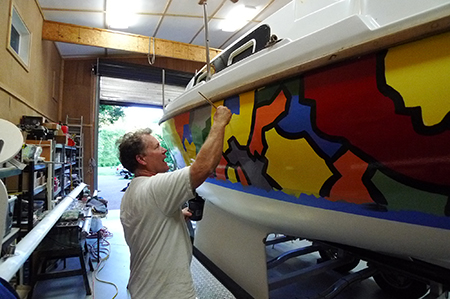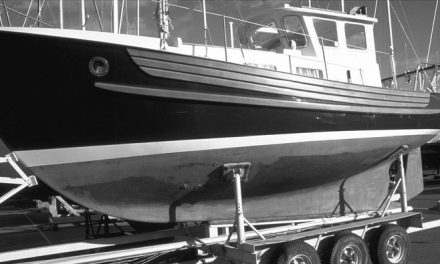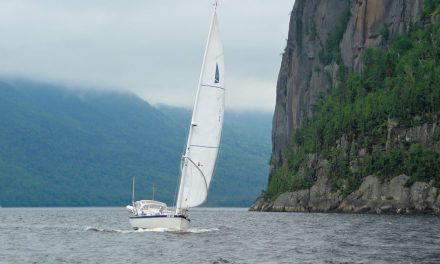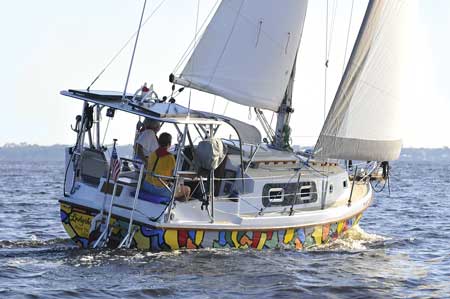
Ladyship started life in 1971 as a twin-keel Westerly Pageant 23, exported from England to a Westerly dealer on the lower Chesapeake Bay. She moved from there to an owner in Virginia and somehow ended up in Corpus Christi, Texas, where she had a couple of owners. We suspect she might have been sunk at some point, possibly the victim of a hurricane, as we found hidden mud debris inside her that could not have arrived there otherwise.
When we found her, she had been confiscated for non-payment of yard storage and was in a salvage yard about to be scrapped. We bought her through an eBay ad. She had no trailer, but had her mast and boom, albeit in sorry shape.
Why?
I had been intrigued with twin-keelers for quite a while after reading about Lord Riverdale’s exploits with Bluebird of Thorne, his twin-keel ocean racer. I then read a treatise by Bray Yacht Design in Canada that further served to kindle my interest. This is perhaps the best argument in their favor and is well worth reading: Bray Yacht Design – Twin Keels.
From a practical standpoint, the Westerly Pageant also boasted interior accommodations still unmatched in any other 23-foot sailboat. It has more than 6 feet of standing headroom below and an enclosed head. The storage capacity is also comparatively large and, while not ever considered a “racer,” it was built in the early days of fiberglass boat construction under Lloyd’s Registry inspection. If anything, it is overbuilt by today’s standards and very solid, if comparatively heavy. My challenge was to see if we could substantially improve the performance of this very roomy, comfortable, but rather stodgy old British design and still retain most of her original character and benefits that are so enduring.

Major surgery, we cut our the aft cockpit seats and cut a hole in the hull
Making a plan
I retained the services of Cortland Steck, the same naval architect we had worked with before on our Alubat modifications (Good Old Boat, March 2013). Cort, who had been with Hunter Marine for quite a while, and I worked together to come up with this makeover of our Pageant 23. We decided to call her a Mark II version, as her changes were substantial enough to almost make her a different boat from the original Laurent Giles design. Westerly built 551 Pageants over about a nine-year production span.
There are always things that hindsight would dictate be done differently, but for the most part, we consider the project to be quite successful and the boat has performed well over several cruises and even in a regatta where she garnered second place on elapsed time in a field of about eight other sailboats of various designs, some of them much larger.
As well as generally cleaning and refinishing the boat, we made a number of major changes.
Rig
The rig was enlarged a little to add a bowsprit and a removable inner forestay. The new bowsprit is made of ipe, a hardwood that is considerably stronger than teak. An inner “soft” forestay now carries a small soft-luff roller-furling (non-reefing) lapper jib that is sheeted to new inboard tracks on top of the cabin. It can be easily removed and stored below when we want to use the larger 130 percent genoa on the headstay roller furler. We use the inner headsail in heavier wind conditions rather than reefing the big genoa, as it has a more efficient shape and can be sheeted closer inboard for higher pointing ability. It replaces the original baby stay, which is no longer needed since we added swept-back spreaders and moved the shroud chainplates aft. Sail area has increased a little as a result and the original tendency to carry too much weather helm has been eliminated by the bowsprit.
Hunter Riddle of Schurr Sails in Pensacola, Florida, designed and built the new loose-footed mainsail and both headsails. As cruisers, we do not normally carry a spinnaker, but the boat is rigged for one.
A new mast tabernacle was fabricated that allows the mast to be stored on the boat when in trailer mode. The pivot point is above the boom, which stays mounted to the tabernacle and does not need to be removed for travel. The original Proctor mast was reused, stripped of its gold-colored anodizing. It was refurbished with new swept-back spreaders that take the shrouds to new chainplates about a foot aft of their original position.

We rebuilt the aft end of the cockpit
Stern arch
I’m a big fan of a sturdy arch assembly on the stern, and I’ve used one on both of our boats. In each case they were built strong enough to serve as the structural attachment point for a split backstay. In Ladyship’s case, the arch also holds an elevated top-mounted traveler that controls the boom and the mainsheet. The traveler and mainsheet lines are led down the sides of the arch into the cockpit through blocks and cam cleats. The top of the arch is a fine place for mounting larger solar panels, and Ladyship carries two 100-watt panels as well as antennas on fold-down mounts for travel. The arch also supports the boom and mast when the mast is down and Ladyship is in travel mode on her trailer.
The sides of the arch structure carry a swiveling outboard motor carrier for the dinghy, a hard-case LifeSling MOB (man overboard) device, a center-mounted block and tackle for lifting the main propulsion outboard motor out of its well high enough for service, and a solid attachment point for the lifelines. The “roof” provided by the arch also serves as a connector point for a canvas panel (removable and without any frame) that extends overhead coverage all the way aft from the dodger. All this makes the cockpit very protected and secure. LED lights mounted under the arch illuminate the cockpit at night.

The outboard motor is raised and lowered on slides inside the well.
Outboard motor

A winch powered by a 12-volt motor provides the muscle.
The most invasive and extreme departure from the original design is the use of an outboard motor in a built-in well that allows the motor to be retracted vertically with a 12-volt winch motor, thus removing all prop drag under sail. A pair of spring-loaded bomb-bay-style door panels automatically close and seal the hull aperture as the motor and prop travel upward.
In order to build the motor well, the original tiller and rudder were removed and the stern cockpit locker and a portion of the cockpit were cut away. A new vertical workboat-type tiller controls a new transom-mounted blade rudder via a line-and-block system. The use of a vertical tiller that does not sweep across the sitting area increased the usable space in the smallish and deep cockpit.

Bomb-bay doors close the motor well when the outboard is retracted. The guard around the propeller pushes the doors open when the motor is lowered.
Moving the rudder aft to the transom also required the fabrication of a new rudder mount and reinforcement of the transom to take the additional loads. The rudder’s new location places it in the propeller’s thrust stream power and makes turning in close quarters like having “power steering.”
Ladyship originally had a small Volvo MD-1 inboard diesel. The motor in use now is a 20-horsepower 4-stroke Tohatsu with a normal short shaft and a low-speed pusher prop. It has turned out to be more power than needed, but was originally selected for its larger alternator. In hindsight, I would now choose something smaller like a Yamaha 4-stroke 9.9 high-thrust motor, which would be smaller and lighter and still able to achieve hull speed. The trade-off for lower alternator output has been more than made up for by the 200 watts of solar panels we have on the stern arch.
 Cockpit
Cockpit
Both sides of the new motor well are now lockers with removable tops for access. One of these lockers houses the 18-gallon gas tank and the other houses the 12-volt winch motor for the motor-lifting rig, the starting battery, and general storage for fenders and other equipment. Tracks on the tops of these lockers support removable one-person seats on each side of the center motor well.
Both of our boats have a very sturdy boarding ladder that’s permanently mounted on the stern and folds up vertically to be secured under the arch. These ladders can be deployed instantly and extend downward enough to allow the boats to be boarded easily and safely while on their trailers.
Cabin
Down below, most of the original design and layout was retained. Because the boat no longer carries an inboard diesel, that space was used to install a Mermaid water-cooled air-conditioning system with vents that discharge into the saloon and, via ducting, into the V-berth area. This unit uses one of three Marelon below-the-waterline through-hulls to bring in cooling water for its compressor. As we sail mostly in southern climates, that makes Ladyship’s interior very comfortable on hot and muggy nights in a marina. We have no AC generator, so the air-conditioning is for dockside use only. At anchor, there is usually enough breeze to keep the cabin cool.
Ladyship has a small enclosed head compartment, which now houses a marine head from SeaLand that sits atop its own gravity-fed holding tank. It has no flush plumbing to clog, just a large foot-operated ball valve. It uses a little fresh water to flush. The tank is connected to a deck pumpout with a Y-valve, so the contents can be discharged overboard via a through-hull with a 12-volt diaphragm pump where that’s legal.
The original stainless-steel freshwater tank located under the V-berth was retained with the addition of a top-mounted inspection port for cleaning. It holds about 13 gallons and is filled through a deck plate. The boat had a foot pump that fed one fixture in the galley sink from this water tank. We added a small 12-volt pressure pump to power this system. It now also supplies flushing water to the head and also to a hose bib mounted in the cockpit for rinsing things (like dogs). This hose bib can be back-fed with a hose and pressure reducer from dockside if desired.
The galley is minimal and includes a small sink with one freshwater faucet. We did replace the old countertop with a new one of Corian. For cooking, we use a non-pressurized two-burner gimbaled Origo alcohol stove. For refrigeration, we carry a single 12-volt Engel MRO40F-U1 fridge-freezer recessed into a cutout in the port quarter berth top adjacent to the galley. We use neither of our quarter berths for sleeping and they now serve for storage only. To access the aft portion of these old quarter berths more easily, we installed a pair of aluminum hatches on the cockpit seats. We installed another matching hatch on the cockpit sole for access to the bilge pumps and the air-conditioner’s cooling-water pump. There is also some storage there for a toolbox.
Ladyship’s saloon has a new fold-up table that lowers into a double-berth position. The forward V-berths are also comparatively large and quite comfortable. We had new cushions made of 4-inch closed-cell foam covered with gray Sunbrella fabric.
The boat originally had a vinyl headliner with a foam backing that had been removed. We elected not to replace any of it, but instead we cleaned the surface and painted it with a single-part epoxy semi-gloss paint over a primer coat mixed with microsphere insulating beads.
As built, the boat had fixed saloon windows and only a pair of small round opening portlights in the head and locker areas. We removed the saloon windows and replaced them with smoke-gray Plexiglas panels that cover the entire area around the cutouts. Four new Vetus opening portlights with screens were then fitted in the Plexiglas. New round Vetus portlights were also installed forward along with a pair of rectangular side portlights for additional ventilation in the V-berth. A forward hatch over the V-berth was rebuilt, reglazed with gray Plexiglas and fitted with a solar-powered vent. New window and cabin interior trim was built of mahogany and stained to match what was left of the original interior woodwork.
The electrical system
The boat had no electrical system when we rescued her. There were remnants of old wiring that had to be removed before we completely re-wired her for both 12-volt DC and 120-volt AC circuits. Shorepower (30 amps) is brought aboard though an external plug aft that has a DEI Marine isolation device on the ground wire. The boat has several internal GFCI (ground fault circuit interrupter) AC sockets, and the air-conditioner has to have shorepower AC as well.
The boat has a Magnum MMS pure-sine-wave inverter/charger on the DC side that feeds a house bank of two GC-12 golf cart batteries. They give us a house capacity of 360 amp hours, which is sufficient for the electronics, Engel fridge, and all the LED lights throughout the boat.
Our electronic package includes a VHF radio and a GPS chart plotter with Wi-Fi capability. The entertainment system is a Tivoli CD player and FM-XM stereo bookshelf system mounted to the forward saloon bulkhead. The boat has active AIS (Automatic Identification System) installed and uses LED running lights. We have a tiller-pilot autopilot. The instrument package includes a conventional bulkhead compass in the cockpit and a single multi-function display head that displays information from the depth sounder and the masthead-mounted sensor for wind speed and direction.
A custom Blue Seas breaker panel controls both the AC and DC sides. The entire DC panel supply is fed through a DC-DC converter that stabilizes the 12-volt power and prevents any voltage spikes that might kill the LED lights. The boat has several internal 12-volt cigarette lighter outlets and a single fan in the V-berth. One of the 12-volt sockets has a cell phone USB charger built into it.
We use a Blue Sky Energy MPPT solar charge controller to handle the power input from our two solar panels that charge the house bank. Our charging sources for the batteries are the solar panels, the motor’s alternator output, and the Magnum inverter/charger when on shorepower.
We moved the house bank of batteries to a more amidships location and left a smaller starting battery aft for the motor. The motor is connected directly to this smaller 12-volt battery and, when it’s fully charged, the engine alternator’s output is then automatically directed to the house bank via a Balmar parasitic charger. The engine battery and the house bank are normally isolated from each other but can be combined in an emergency.
One of the cast-iron keels, the aluminum arch, and the lifelines are all electrically bonded to the mast for a lightning-discharge path to the water.
Rob cut about 6 inches off the bottom of each keel with a gas-powered concrete saw.

Rob cut about 6 inches off the bottom of each keel with a gas-powered concrete saw.
Twin keels
The sail area and the ballast/displacement ratio were recalculated to evaluate what could be safely done to improve performance. Naval architect Cortland Steck determined that our keels could be shortened by about 6 inches to give us a more favorable sail area/displacement ratio in the high teens and also to reduce wetted-surface area. These boats were over-ballasted to begin with and can benefit from some ballast removal. The specified cast iron (about 600 pounds) was removed using a gas-powered concrete saw with a diamond blade — not a job for the faint of heart!
To maintain and improve our pointing ability, we reshaped the keels’ airfoil profiles to make them slightly asymmetrical, as was originally desired in the Laurent Giles design but not implemented by Westerly due to production cost considerations. The inside surfaces of the keels were built up by about ½ inch at the apex of the chord section and the external sides were flattened some by shape sanding before all the corrosion pitting was filled. Both were then faired out and painted with an epoxy barrier. The resulting asymmetrical profile shape tends to lift the boat to weather and also reduces heeling a little.
The keels are attached to the boat with sturdy 1-inch-diameter stainless-steel bolts. We inspected them closely when we dropped the keels to clean and reseal the hull-to-keel joints with 3M 5200 and found them to be in great shape. Because the boat has no inboard engine and attendant prop shaft, Ladyship’s bilges are normally completely dry. The air-conditioner’s condensate never gets into the bilges because it is removed by a venturi suction device powered by the water stream exiting the cooling water circuit.
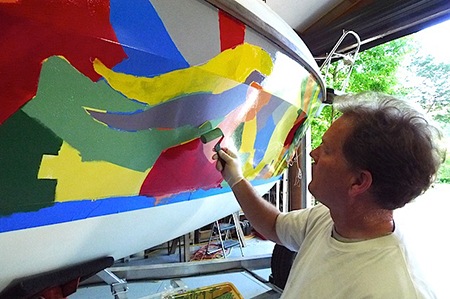
Artist Bill Barnhart adds finishing touches to the crazy topsides!
Miscellaneous
The boat has an automatic 12-volt bilge pump and a manual diaphragm bilge pump with the pump handle socket in the cockpit.
Externally, we were able to repair and refurbish the original teak rubrail while using an automotive spray enamel to repaint any of the deck and topsides areas that we did not cover with Kiwi-Grip non-skid product.
A new cockpit dodger was built by JSI in Florida, who also built the stern arch and mast tabernacle. They also did the new lifelines and supplied a lot of the running rigging and new standing rigging.
We carry three anchors: a primary Bulwagga, a second claw-style on the bow, and a single smaller claw as our stern anchor. I fabricated new PVC chain pipes for the two bow anchor rodes that are now led down into a separated stowage area all the way forward under the V-berth. The rode for the stern anchor is stowed adjacent to the fuel tank locker.
We carry Ladyship on a custom aluminum tandem-axle trailer with surge brakes. The trailer has an extending tongue that allows for launching at most ramps. After the modifications to the keels, the boat now draws 3 feet and, including the trailer, weighs in at around 7,500 pounds. We pull with a GMC 2500HD diesel truck.
The hull’s paint job was done by a friend and fellow sailor we met at Lake Havasu. Bill Barnhart is an internationally recognized fine artist, painter, print maker, architectural designer, and sculptor. He’s also a fine sailor and a boat restorer of considerable skill.

Ladyship is frequently trailered, albeit behind a ¾-ton truck.
Good Old Regatta fun
Ladyship participated in the 2015 St. Petersburg Classic (Good Old Boat) Regatta, a charity event for Meals on Wheels put on every year by the St. Petersburg Yacht Club and St. Petersburg Sailing Association. Bill Wright crewed for Gabi and me and we were amazed at how well Ladyship performed. We raced in the Good Old Fun class that consisted of older boats of many different designs. Our class was not under any handicap rules; the boats were placed simply on elapsed time over the usual triangular club-racing course on Tampa Bay. We came in second in a field of about eight other boats and even beat a few others on elapsed time that were in the faster handicapped classes. Most of the race was in light-air conditions in which any stock Westerly twin-keeler would have found herself barely able to finish. Many of the other boats were DNF due to light air. One skipper was certain we had our motor on — LOL. We had it fully retracted!
In Good Old Boat May 2016, Allen Penticoff reviewed the Westerly Pageant, a 23-foot twin-keel sloop built by Westerly Marine in England. The boat had been highly customized, so we cautioned readers that Ladyship, as she is named, is not representative of all Pageants. In fact, she is unique and well worked on, we thought readers would enjoy learning more about her refit from the man responsible. Here, in his own words, is Rob Hoffman’s story.
Article from Good Old Boat Magazine, May/June 2016.


